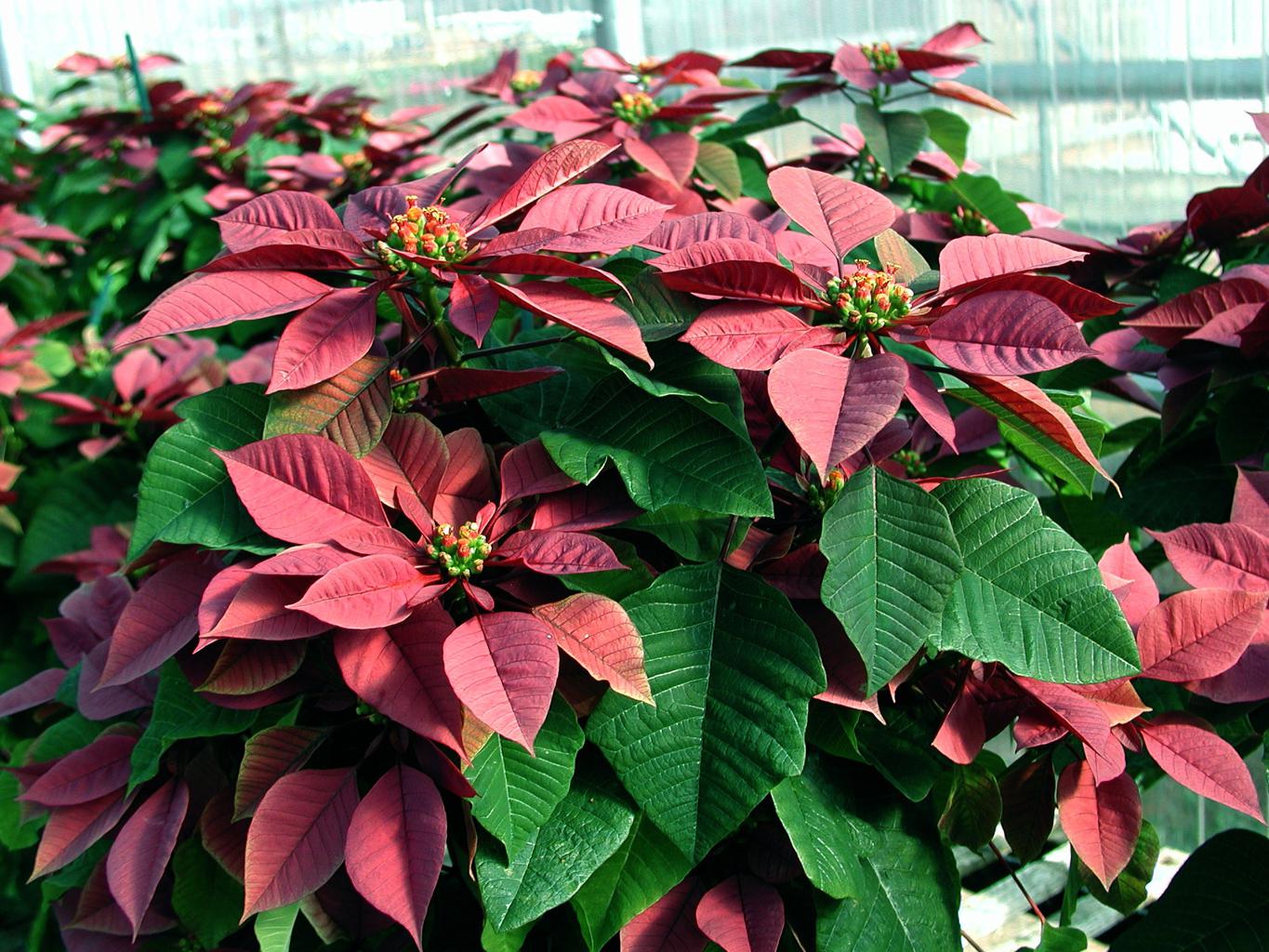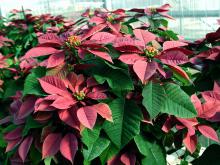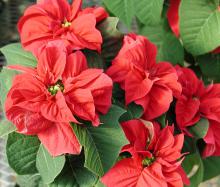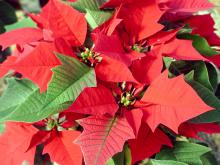Information Possibly Outdated
The information presented on this page was originally released on December 10, 2001. It may not be outdated, but please search our site for more current information. If you plan to quote or reference this information in a publication, please check with the Extension specialist or author before proceeding.
Poinsettias provide traditional beauty
By Norman Winter
MSU Horticulturist
Central Mississippi Research & Extension Center
Trends toward richer colors during the holiday season may be one reason Plum Pudding, a new maroon poinsettia, will be in demand this year. Excelling in consumer and grower trials, this beauty also is sure to delight lots of Mississippi State University fans who still want to show their school colors during the holidays.
Plum Pudding (top, left photo) originated from Paul Ecke Ranch in California, which has been bringing us poinsettias since the late 1800s. One of the reasons this color is so popular in Mississippi may not be any allegiance to MSU, but the fact that many dining rooms, studies and living rooms now have a maroon, burgundy or dark mauve influence. While red seems to clash, Plum Pudding excels.
Before my Ole Miss friends go off on a tirade, remember that we have always had red poinsettias. In fact, another hot new poinsettia for the year is called Winter Rose. Its most popular color is red, but it is available in other colors as well.
When I first saw Winter Rose (middle, right photo), I thought it would be a market flop. As often happens I am getting to eat my boots. The Winter Rose is flying off the shelves. If you want these poinsettias with curled rose-like red bracts, you had better shop fast.
This year Mississippi growers will produce between 250,000 and 300,000 poinsettias, so you can enjoy a beautiful, healthy poinsettia this holiday season. Most shoppers know poinsettias by color, not variety. The colorful parts of a poinsettia are actually modified leaves known as bracts. The true flowers are the small yellow buttons in the centers of the bracts. One popular variety is the Sonora Jingle Bells that have dark red bracts with white flecks, giving it a peppermint look.
Next to the maroon Plum Pudding, my favorite is Pepride (bottom, left photo), which has dark-green leaves and deep-red bracts that are shaped like oak leaves. Freedom is a dark-red variety with dark-green leaves. It is awfully hard to find a prettier poinsettia than this one. Silver Star is another poinsettia that has garnered my attention. This variety has dark-red bracts but also variegated foliage of silver and green.
Monet is my favorite pink variety. Unless you prefer red, this may be the most beautiful poinsettia ever developed. The bracts are pink with drifts of a darker pink or burgundy, giving it a painted look. Marble Star is another great pink variety with a creamy white variegation that gives it a marble look.
One myth that has hung around for years is that poinsettias are poisonous. Research at Ohio State University has proven conclusively that the poinsettia plant, and its juices are not poisonous.
Look for strong, stiff stems, good leaf and bract retention, and no signs of wilting, breaking or drooping. Carefully inspect packaged poinsettias before purchasing them. Poinsettias left in sleeves for an extended period of time may become unhealthy.
Transport poinsettias carefully. Strong winds or short-term exposure to temperatures below 40 degrees can permanently damage the plants. Use plant sleeves or large shopping bags for added protection in cold weather. When possible, place the plant in the sunniest exposure in your home. A window that faces south, east or west is better than one facing north. Don't let the bracts touch the cold windowpanes, since freezing outdoor temperatures can cause damage.
Your poinsettia was greenhouse grown at day temperatures of 70 to 72 degrees and night temperatures of about 60 degrees. Obviously, your plant will last longer if you provide similar temperatures, but this is not always possible. You can help the next critical area, and that is with watering. Two problems most often encountered with poinsettias center around watering. With the busy holiday season, forgetting to water can be disastrous for a poinsettia.
Examine the soil daily. When the surface is dry to the touch, water until it runs freely out the drainage hole in the container. The second major problem results from decorative wraps that can trap water and suffocate the roots. Be sure to pour out any excess water.






